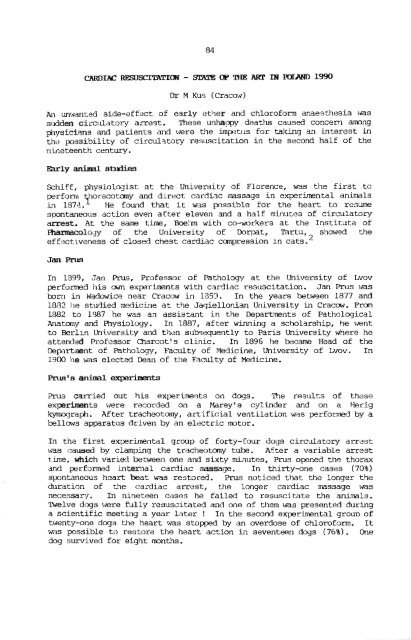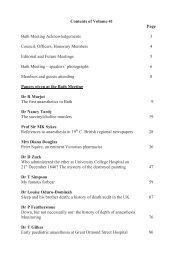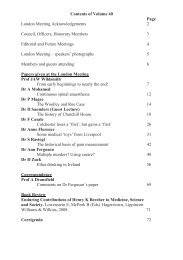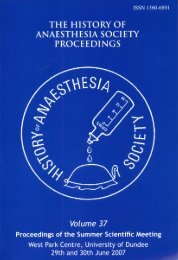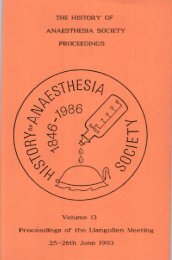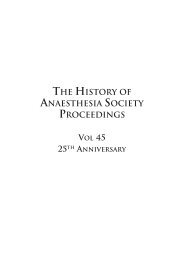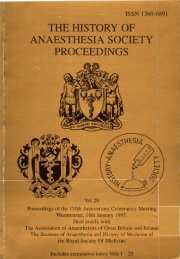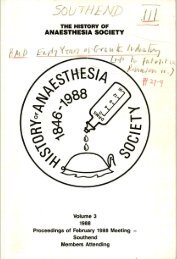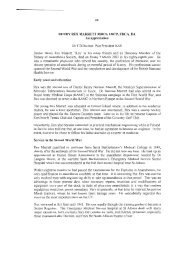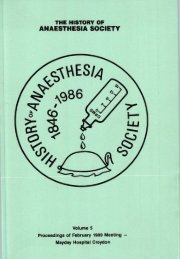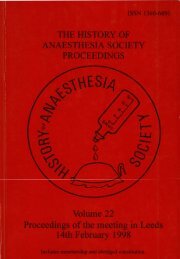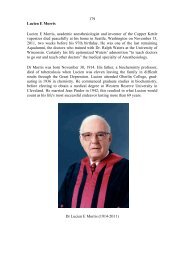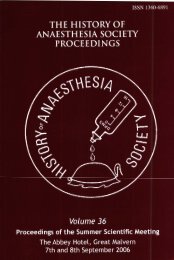Volume 9b - History of Anaesthesia Society
Volume 9b - History of Anaesthesia Society
Volume 9b - History of Anaesthesia Society
You also want an ePaper? Increase the reach of your titles
YUMPU automatically turns print PDFs into web optimized ePapers that Google loves.
Dr M Kus (LYacori)<br />
An un-.rlanted side-effect <strong>of</strong> early ether and chlor<strong>of</strong>orm anaesthesia rms<br />
sudden ciii~datory arrest. These unham deaths caused concern ammg<br />
physicians and patients and were the impetus for &king an interest in<br />
the possibility <strong>of</strong> circul2tory resuscitation in the second half <strong>of</strong> the<br />
nineteenth century.<br />
Early animal shdies<br />
Schiff, physiolqist at the University <strong>of</strong> Florence, was the first to<br />
perform Yracotany and direct cardiac mssage in experimental animals<br />
in 1974. He found that it was pssible for the heart to resume<br />
spontaneous action even aeter eleven and a half minutes <strong>of</strong> circulatory<br />
arrest. At the same time, Boe:hm with co-workers at the Institute <strong>of</strong><br />
Pharmacology <strong>of</strong> the University <strong>of</strong> Dorpat, Tartu, showed the<br />
effectiveness <strong>of</strong> closed chest cardiac canpression in cats.2<br />
Jan Prus<br />
In 1399, Jan Prus, Pr<strong>of</strong>essor <strong>of</strong> Pathology at the University <strong>of</strong> Lvov<br />
performed his own expriments with cardiac resuscitation. Jan Prus was<br />
born in Wadowice near Cram in 1853. In the years between 1877 and<br />
1882 he studied mdicine at the Jaqiellonian University in Cracow. FYun<br />
1882 to 1587 he was an assistant in the Departments <strong>of</strong> Pathological<br />
Anatomy and Physiology. In 1887, after winning a scholarship, he rmnt<br />
to Berlin University and then sub~quently to Paris University where he<br />
attended h-oEessor Charcot's clinic. In 1896 he bctcame Head <strong>of</strong> the<br />
Department <strong>of</strong> Pathology, Faculty <strong>of</strong> Fledicine, University <strong>of</strong> Lvov. In<br />
1900 he was elected Dean <strong>of</strong> the Faculty <strong>of</strong> Medicine.<br />
Prus's animal -ts<br />
m carried out his experiments on dogs. Tne results <strong>of</strong> these<br />
experiments were recorded on a Marey's cylinder and on a Herig<br />
kyrmqraph. After tracheotomy, artificial ventilation was performed by a<br />
bellows apparatus driven by an electric mtor.<br />
In the first experimental group <strong>of</strong> forty-four doys circulatory arrest<br />
was caused by clamx~ing the tracheotomy tube. After a variable arrest<br />
rime, which varied between one and sixty minutes, Prus opened the thorax<br />
and gerfanned internal cardiac massage. In thirty-one cases (70%)<br />
s~nhneous heart beat was restored. Prus noticed that the longer the<br />
duration <strong>of</strong> the cardiac arrest, the longer cardiac mssage was<br />
necessary. In nineteen cases he failed to resuscitate the animals.<br />
mlve dcqs rere fully resuscitated and one <strong>of</strong> them was presented during<br />
a scientific meeting a year later ! In the sacond experimental grow <strong>of</strong><br />
twenty-one dogs the heart was stopped by an overdose <strong>of</strong> chlor<strong>of</strong>orm. It<br />
was possible to restore the heart action ia seventeen doys (76%). One<br />
dog survived for eight months.


